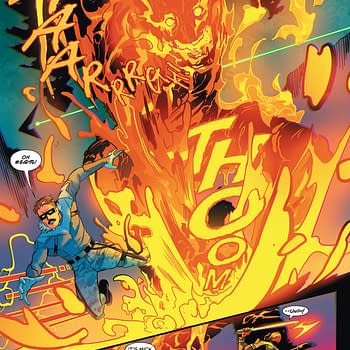Posted in: Comics, Recent Updates | Tagged: Comics, entertainment, Jake Myler, M. Nicholas Almand, oni press, Orphan Blade
The Late M. Nicholas Almand's Orphan Blade Feels Rusty, Unsure Of Itself
By Cameron Hatheway

In the prologue we learn that at the dawn of the 17th century a band of alchemists, priests, and sorcerers gathered to open the heavens and look upon the face of God. What they opened instead was a portal to another world, releasing monstrous Kaiju to Earth. For years the Kaiju destroyed towns, cities, and countries, reigning supreme and undefeated until a coordinated attack finally killed one. With the Kaiju's bones, weapons called Artifacts were created, and soon after the Kaiju were hunted to extinction from the result of more weapons being made from their bones. While the Kaiju were defeated, the lands where their carcasses once lay became infected with a Blight that left the lands deserted and forced its inhabitants to relocate and fight for resources. The weapons that were once used to kill Kaiju were then used to battle rival groups, and a new sort of chaos spread.

Hadashi stumbles upon a group of assassins known as the Five Fingers of Death during one errand, and steals an Artifact called the Orphan Blade which gives the bearer great powers and protects them by killing any perceived threat. Nothing but pandemonium follows Hadashi and his friends as they try to get the Orphan Blade back to Dr. Africa's castle, while fleeing the Five Fingers of Death and other blighted creatures along the way.
The art in Orphan Blade left me with mixed feelings. On one hand, some of the action sequences were enjoyable, with amazing backgrounds and creatures throughout. And then there's the style of the characters: it strongly reminded me of the Avatar: The Last Airbender series with its American Anime-influenced look and feel. The comic isn't a manga, but does mix styles of Western comics and Asian manga, making it sometimes confusing to keep track. While Myler is no doubt a talented artist, it looks as if he had a hard time bringing a solid, consistent feel to the comic.

Almand unfortunately passed away from cancer back in October of 2013, but his Orphan Blade will live forever in libraries and bookshelves worldwide. It shows that he was a man full of brilliant ideas, and a passionate world builder in the medium of comics. While Orphan Blade isn't the perfect comic book, it's perfect at capturing the type of writer and person Almand was.
Orphan Blade (Oni Press)
Written by M. Nicholas Almand
Illustrated by Jake Myler
160 Pages, FC
$19.99
Cameron Hatheway is the host of Cammy's Comic Corner, an audio podcast. You can mail him a blighted toad and/or an ancient Artifact on Twitter @CamComicCorner.















